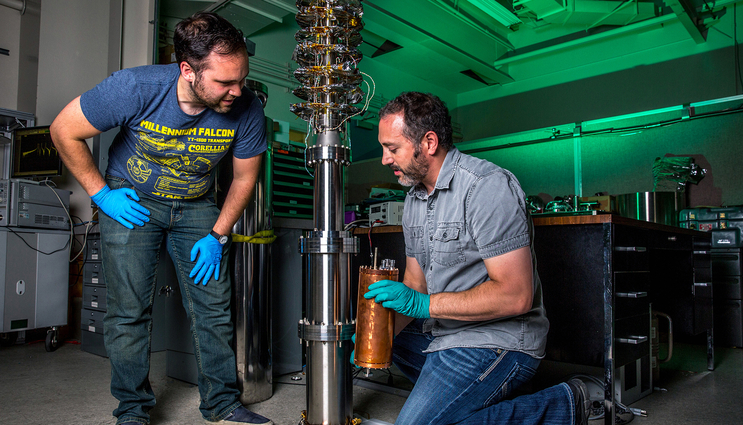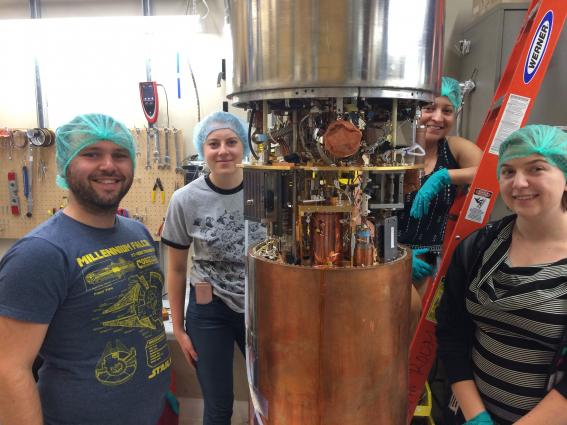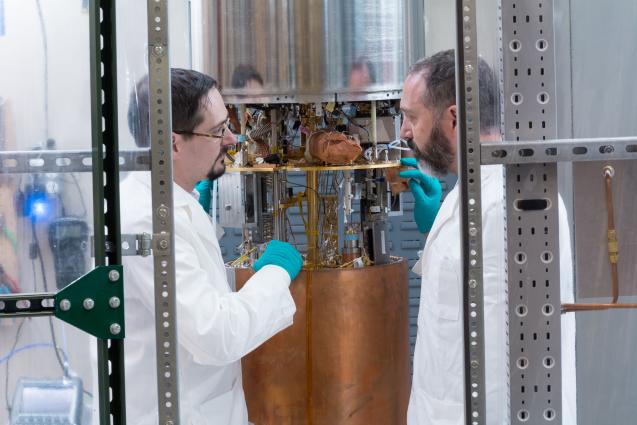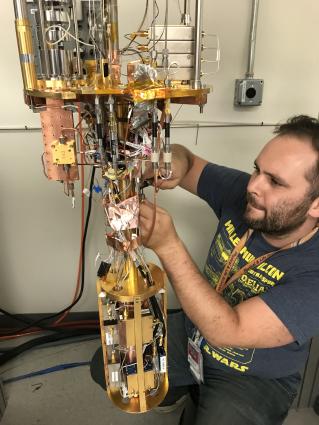The definitive search for axion dark matter
 (Download Image)
LLNL postdoc Nathan Woollett and LLNL staff scientist and ADMX co-spokesman Gianpaolo Carosi work on the cryostat system in which LLNL places its test microwave cavity. Photo by George Kitrinos/LLNL.
(Download Image)
LLNL postdoc Nathan Woollett and LLNL staff scientist and ADMX co-spokesman Gianpaolo Carosi work on the cryostat system in which LLNL places its test microwave cavity. Photo by George Kitrinos/LLNL.
Forty years ago, scientists theorized a new kind of low-mass particle that could solve one of the enduring mysteries of nature: what dark matter is made of. The search for that particle has just begun.
This week, the Axion Dark Matter Experiment (ADMX) unveiled a new result (published in the April 9 edition of Physical Review Letters) that places it in a category of one: it is the world’s first and only experiment to have achieved the necessary sensitivity to "hear" the telltale signs of dark matter axions. This technological breakthrough is the result of more than 30 years of research and development, with the latest piece of the puzzle coming in the form of quantum-enabled devices that allows ADMX to listen for axions more closely than any experiment ever built.
ADMX was commissioned and built at Lawrence Livermore National Laboratory (LLNL) in 1994 and operated there until it moved to the University of Washington in 2010 to undergo a series of upgrades. It is managed by the U.S. Department of Energy’s Fermi National Accelerator Laboratory. This new result, the first from the second-generation run of ADMX, sets limits on a small range of frequencies where axions may be hiding, and sets the stage for a wider search in the coming years.
ADMX is the first experiment to reach plausible dark matter axion coupling ranges in the micro (eV) mass range, the best search region. For comparison, the electron is 511 keV in mass (or a factor of 1011 times more massive than what the axion is expected to be).
"This result signals the start of the true hunt for axions," said Fermilab’s Andrew Sonnenschein, the operations manager for ADMX. "If dark matter axions exist within the frequency band we will be probing for the next few years, then it’s only a matter of time before we find them."
One theory suggests that the dark matter that holds galaxies together might be made up of a vast number of low-mass particles, which are almost invisible to detect as they stream through the cosmos. Efforts in the 1980s to find this particle, named the axion by theorist Frank Wilczek, currently of the Massachusetts Institute of Technology, were unsuccessful, showing that their detection would be extremely challenging.
ADMX is an axion haloscope — essentially a large, low-noise, radio receiver, which scientists tune to different frequencies and listen to find the axion signal frequency. Axions almost never interact with matter, but with the aid of a strong magnetic field and a cold, dark, properly tuned, reflective box, ADMX can "hear" photons created when axions convert into electromagnetic waves inside the detector.
"If you think of an AM radio, it’s exactly like that," said Gray Rybka, co-spokesperson for ADMX and assistant professor at the University of Washington. "We’ve built a radio that looks for a radio station, but we don't know its frequency. We turn the knob slowly while listening. Ideally we will hear a tone when the frequency is right."
This detection method, which might make the "invisible axion" visible, was invented by Pierre Sikivie of the University of Florida in 1983, as was the notion that galactic halos could be made of axions. Pioneering experiments and analyses by a collaboration of Fermilab, the University of Rochester and the Brookhaven National Laboratory, as well as scientists at the University of Florida, demonstrated the practicality of the experiment. This led to the construction in the late 1990s of a large-scale detector at Lawrence Livermore that is the basis of the current ADMX.
It was only recently, however, that the ADMX team has been able to deploy superconducting quantum amplifiers to their full potential, enabling the experiment to reach unprecedented sensitivity. Previous runs of ADMX were stymied by background noise generated by thermal radiation and the machine’s own electronics.
Fixing thermal radiation noise is easy: a refrigeration system cools the detector down to 0.1 Kelvin (roughly -460 degrees Fahrenheit). But eliminating the noise from electronics proved more difficult. The first runs of ADMX used standard transistor amplifiers with noise temperatures of several Kelvin, which would dominate the noise in the system. The key technological leap came from John Clarke, a professor at the University of California, Berkeley, who developed a quantum-limited amplifier for the experiment. This much quieter technology, combined with the refrigeration unit, reduces the noise by a significant enough level that the signal, should ADMX discover one, will come through loud and clear.
LLNL built the currently installed microwave cavities (both the main cavity and the "sidecar" in-situ testbed cavity), the motion control system and is in the process of developing the cavity for the next frequency range, if the axion isn’t discovered in the current data run. In addition LLNL was responsible for systems tests on the superconducting electronics (dubbed the "SQUIDADEL" since it houses multiple SQUID based RF amplifiers) in a LLNL dilution refrigerator.
"This combined cavity and quantum electronics package really makes up the heart of the ADMX experiment and the smaller ‘side-car’ cavity allows for in-situ testing of new technologies without affecting the main experiment." said Nathan Woollett, LLNL postdoctoral researcher and lead for side-car cavity operations.
"The initial versions of this experiment, with transistor-based amplifiers would have taken hundreds of years to scan the most likely range of axion masses. With the new superconducting detectors, we can search the same range on timescales of only a few years," said Gianpaolo Carosi, co-spokesman for ADMX and scientist at LLNL.
"This result plants a flag," said Leslie Rosenberg, professor at the University of Washington and chief scientist for ADMX. "It tells the world that we have the sensitivity and have a very good shot at finding the axion. No new technology is needed. We don’t need a miracle anymore, we just need the time."
ADMX will test millions of frequencies at this level of sensitivity. If axions are found, it would be a major discovery that could explain not only dark matter, but other lingering mysteries of the universe. If ADMX does not find axions, that may force theorists to devise new solutions to those questions.
This research is supported by the U.S. Department of Energy Office of Science, the Heising-Simons Foundation and research and development programs at LLNL and the Pacific Northwest National Laboratory.
The ADMX collaboration includes scientists at Fermilab, the University of Washington, Lawrence Livermore, Pacific Northwest National Laboratory, Los Alamos National Laboratory, the National Radio Astronomy Observatory, the University of California at Berkeley, the University of Chicago, the University of Florida and the University of Sheffield.
Contact
 Anne M. Stark
Anne M. Stark
[email protected]
(925) 422-9799
Related Links
ADMXUniversity of Washington
Fermi National Accelerator Laboratory
Physical Review Letters
Tags
Physical and Life SciencesFeatured Articles










